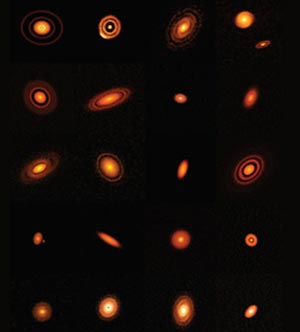
Unveiling New Insights Into Planet Formation Around Young Stars

Compilation of all 20 protoplanetary discs observed using ALMA in the DSHARP campaign. The colours are not true-to-life and were selected to show greater detail. They show a number of structures including rings, gaps, and spiral-shaped patterns at a wide range of distances from their host stars, from a few astronomical units (AUs) to up to 100 AU, which is more than three times the distance of Neptune from our Sun. These structures consist of dust particles that glow in millimetre-wavelength light. It is assumed that they are signatures of planet formation.
Source: ALMA (ESO / NAOJ / NRAO), S. Andrews et al.; NRAO / AUI / NSF, S. Dagnello
Hitherto unknown structures in belts of dust and gas around young stars are providing new insights into the birth of planets along with compelling fodder for research. They were discovered by an international team of astronomers that studied 20 of these so-called protoplanetary discs in a months-long observing campaign.
Heidelberg researchers made substantial contributions to the effort. The observations were carried out using a group of telescopes known as the Atacama Large Millimeter / Submillimeter Array (ALMA). “Our observations indicate that planets can form much faster than previously assumed,” states Prof. Dr Cornelis Dullemond of the Centre for Astronomy of Heidelberg University (ZAH), one of the campaign leaders.
Until now, the process of planetary formation and its associated physical mechanisms is still poorly understood. The leading models for planet formation hold that planets are born over millions of years by the gradual accumulation of dust and gas inside a protoplanetary disk, beginning with grains of dust that coalesce to form larger and larger rocks.
In the current Disk Substructures at High Angular Resolution (DSHARP) campaign, the astronomers studied dust particles that naturally glow in millimetre-wavelength light. ALMA and its extremely sharp images helped to map the density distribution of the small, solid particles around young stars.
According to the researchers, the most compelling interpretation of these observations is that large planets like Neptune or Saturn form much faster than current theory would allow. Such planets also tend to form in the outer reaches of their solar systems at tremendous distances from their host stars.
“We are seeing distinct details around a wide assortment of young stars of various masses, including prominent rings and gaps at a wide range of distances from their host stars. These appear to be the hallmarks of recently born planets,” explains Prof. Dullemond.
The latest observations may explain how rocky Earth-like planets are able to form and grow. For decades, astronomers have puzzled over a major hurdle in planet-formation theory. “When dusty bodies reach the size of pebbles, the dynamics of a smooth protoplanetary disk would induce them to fall in on their host star, never acquiring the mass necessary to form planets”, explains Cornelis Dullemond.
Yet the ALMA images show that these “pebbles” are trapped in rings. “Each of these rings contains many tens of Earth-masses worth of this dusty material. They are the ideal sites for new planets to be formed,” continues the Heidelberg astronomer. “The dense dusty rings provide a safe haven for rocky worlds to fully mature.”
Spearheading the DSHARP campaign along with Prof. Dullemond were Dr Sean Andrews, astronomer at the Harvard-Smithsonian Center for Astrophysics (USA), Prof. Dr Andrea Isella of Rice University (USA) and Prof. Dr Laura Pérez of the University of Chile. The results of their research were published in a series of papers and summarised in a special issue of “Astrophysical Journal Letters”.
Contact:
Communications and Marketing
Press Office
Phone +49 6221 54-2311
presse@rektorat.uni-heidelberg.de
Dr Guido Thimm
Centre for Astronomy of Heidelberg University (ZAH)
Phone +49 6221 54-1805
thimm@ari.uni-heidelberg.de
http://www.ita.uni-heidelberg.de/~dullemond/index.shtml?lang=en












